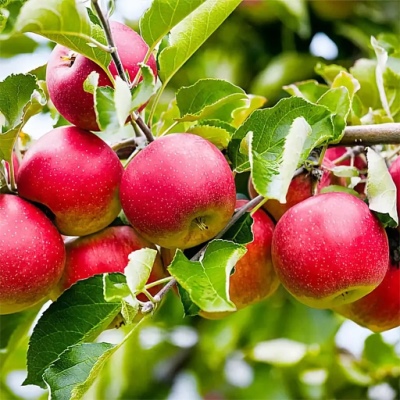
- Authors: USA
- Taste: sour sweet
- Fruit weight, g: 150-190
- Fruit size: average
- Yield: 250 kg / ha and more
- Frequency of fruiting: unsharply periodic
- The beginning of fruiting varieties: for 3-4 years
- Ripening terms: early autumn
- Removable maturity: in the second-third decades of August
- Keeping quality: one to two months
American breeders have at times succeeded in breeding fruit crops no less than their Russian or European counterparts. One of the results of their efforts was the Prima apple tree. It is necessary to figure out whether she is really capable of "performing the first part in a garden ensemble."
Breeding history of the variety
The plant was obtained by complex crossing. The base variety turned out to be M. floribunda 821. A complex combination of Welsey, Rum Beauty, Golden Delicious, Melba and derivatives from these varieties was also taken for the hybrid. Breeding work was carried out in the United States in the 1950s. Prima became the 4th generation in hybridization. Subsequently, she herself served as the source material for breeding other apple trees, including in our country.
Description of the variety
Prima's oval crown resembles an inverted pyramid in shape. Rounding is typical for it. The density is quite high, but not excessive. The leaves are small to medium in size. Other botanical features are:
corrugated type of oval and oblong-oval leaves;
branches covered with brownish bark;
branches off the plane of the trunk at a right or fairly close angle;
average thickness of shoots;
average size of flowers resembling saucers.
Features, pros and cons
Prima is convincingly supported by:
early maturity;
little susceptibility to scab;
large size of fruit;
attractive properties of the crop;
the ability to transport the harvested apples far away.
However, even this plant is excellent in general:
often prone to shedding of fruits;
can easily get sick with powdery mildew;
yields irregularly.
Ripening and fruiting
Prima is not self-fertile. In order for it to bring a good harvest of fruits, you need pollinating varieties. The best candidates for experience are Welsey, Alenushkino and Kuban spur. You can remove the fruits in normal weather in the second or third decade of August. Gardeners have the right to count on their appearance after 3-4 years of planting.
Growing regions
Prima's resistance to winter conditions is low. Already in the suburbs, it can freeze out without careful shelter. An open culture in more complex regions - the Leningrad Region, the Urals and Siberia - is all the more nearly impossible. The best prospects are found in the Kuban, in the Azov region. It is there that the mild climate in combination with competent agricultural technology allows you to count on a decent result.
Yield
In terms of fertility, Prima is indeed attractive. The harvest from 1 hectare of a large plantation can reach 250 centners. Moreover, this indicator is not yet maximum. What is also very important, the marketability of the crop is from 88 to 90%, therefore there are no problems with its sale. In private farms, by the 6th year, the collection is about 40 kg of fruits, by the age of 10 this figure increases to 120 kg.
Fruits and their taste
For apples of this variety, a pale yellow or greenish-yellow color is typical. The blush is red, dark, often forming a continuous coating. The average weight of fruits is 150-190 g. After harvesting, they can lie from 30 to 60 days. Sweet and sour taste is characteristic; the share of sugars accounts for 9.9% of the apple mass.

Growing features
Prima is a typically "sunny" apple tree. But even in the most favorable and bright area, it needs protection from fungal infections. If you plant a culture in the shade, you will have to part with the hope for the ovary. Natural ventilation also plays an important role. However, drafts are also contraindicated for this variety.
You can grow Prima on black soil, on stone, and on loam. Even sandy loam and podzol are much better suited than other varieties. But it is important that the acidity and salinity are neutral, otherwise even the best soil is useless. Finding groundwater - at least at a depth of 2.2 m. And it is even better that they go 2.6 m deep or more.
Other recommendations are as follows:
vary the distance between the apple trees according to the height of the stock;
prepare holes 5-8 months before planting;
the depth of the excavations should be 0.6-0.7 m (taking into account drainage, substrate and clod of earth);
each planted apple tree is irrigated with 35-40 liters of water;
in the fall, I will be planted after leaf fall, but when exactly 35-50 days are left before frost;
watering is best organized weekly, especially during hot dry periods;
the crown is formed before the buds emerge or after the completion of leaf fall.






The apple tree is a popular fruit crop among gardeners. It can be found in many summer cottages. But at the same time, such trees are often affected by various diseases. It is very important to recognize the disease in time and carry out the necessary procedures for a speedy recovery. Otherwise, the fruits will be spoiled, and the tree itself may die altogether.












































































